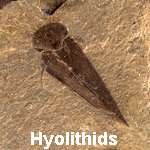Hyolithids
 Hyoliths are an extinct group of animals that had cone shaped shells. They lived from the Cambrian to the Permian, but were most diverse and abundant during the Cambrian. Most paleontologists think that they lived on the sea-floor, did not move around much, and fed on organic material in the sediment (deposit feeders). Many paleontologists agree that hyoliths are related to mollusks, though the closeness of this relationship remains in dispute.
Hyoliths are an extinct group of animals that had cone shaped shells. They lived from the Cambrian to the Permian, but were most diverse and abundant during the Cambrian. Most paleontologists think that they lived on the sea-floor, did not move around much, and fed on organic material in the sediment (deposit feeders). Many paleontologists agree that hyoliths are related to mollusks, though the closeness of this relationship remains in dispute.
Three species of hyolithids known from the Cambrian of Utah include:
- Haplophrentis reesei Babcock & Robison, 1988
- "Hyolithes" idahoensis Resser, 1938
- "Hyolithes" comptus Howell, 1946
Many specimens are well-preserved and show the distinctive cone-shaped shell, the operculum (a “trap-door” that covered the front end of the animal), and the paired spines called “helens”, which are thought to have been used for stabilization on the sea-floor.
Gallery of Hyolithids
Note: Marks on all scale bars are centimeters (cm).
Haplophrentis reesei Babcock & Robison, 1988

KUMIP 204339 (Holotype). Spence Shale Member of the Langston Formation, Wellsville Mountains, Box Elder County, Utah. Figures 5.2 and 6.5 in Babcock & Robison (1988).

KUMIP 204340 (Paratype). Spence Shale Member of the Langston Formation, Wellsville Mountains, Box Elder County, Utah. Figures 5.1 and 6.4 inBabcock & Robison (1988) .

KUMIP 204341 (Paratype; part and counterpart). Spence Shale Member of the Langston Formation, Wellsville Mountains, Box Elder County, Utah. Figures 5.3 and 6.6 in Babcock & Robison (1988).

KUMIP 204342 (Paratype; operculum only). Spence Shale Member of the Langston Formation, Wellsville Mountains, Box Elder County, Utah. Figure 5.4 in Babcock & Robison (1988).

KUMIP 204343 (Paratypes; two specimens). Spence Shale Member of the Langston Formation, Wellsville Mountains, Box Elder County, Utah. Figure 1.1 in Babcock & Robison (1988).

KUMIP 204352 (Paratype). Spence Shale Member of the Langston Formation, Wellsville Mountains, Box Elder County, Utah. Figure 1.2 in Babcock & Robison (1988).

KUMIP 204383 (Paratype; part and counterpart). Spence Shale Member of the Langston Formation, Wellsville Mountains, Box Elder County, Utah. Figures 5.5 and 6.1 in Babcock & Robison (1988).

KUMIP 204384 (Paratype; part and counterpart). Spence Shale Member of the Langston Formation, Wellsville Mountains, Box Elder County, Utah. Figures 5.6 and 6.3 in Babcock & Robison (1988).
"Hyolithes" idahoensis Resser, 1938

KUMIP 204346 (operculum only). Spence Shale Member of the Langston Formation, Wellsville Mountains, Box Elder County, Utah. Figure 9.3 in Babcock & Robison (1988).

KUMIP 204385 (Part and counterpart). Spence Shale Member of the Langston Formation, Wellsville Mountains, Box Elder County, Utah. Figures 9.1a and 9.1b in Babcock & Robison (1988).

KUMIP 204345. Spence Shale Member of the Langston Formation, Wellsville Mountains, Box Elder County, Utah. Figure 9.2 in Babcock & Robison (1988).
"Hyolithes" comptus Howell, 1946
